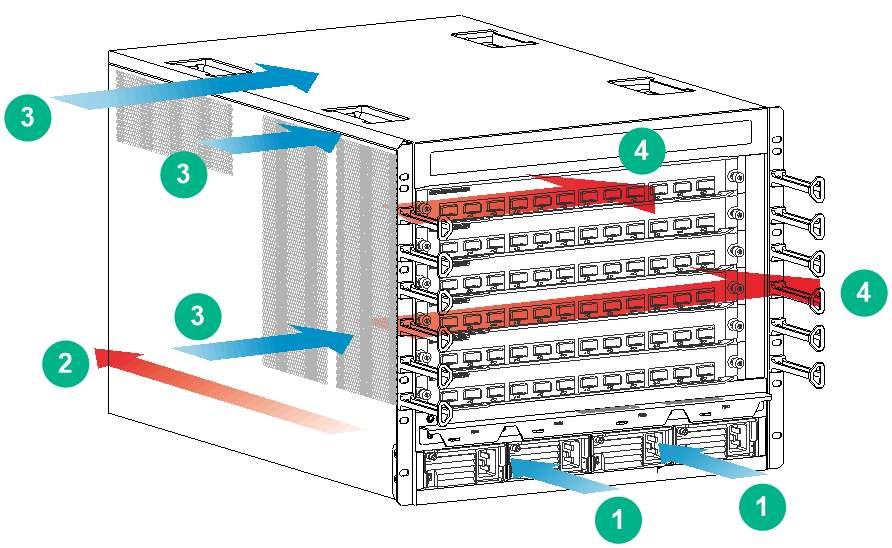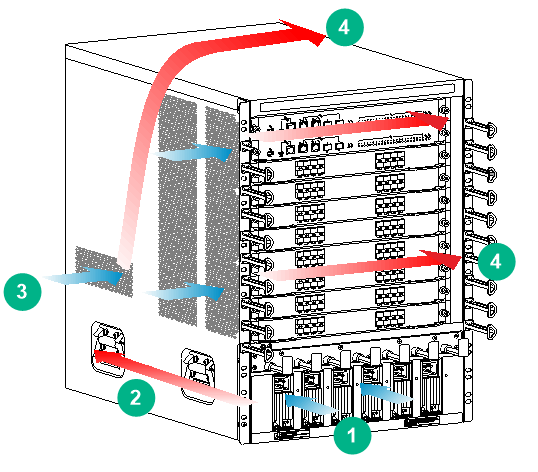- Table of Contents
-
- H3C S10500X Switch Series Installation Guide-6W108
- 00-Preface
- 01-Chapter 1 Preparing for Installation
- 02-Chapter 2 Installing the Switch in a rack
- 03-Chapter 3 Installing FRUs
- 04-Chapter 4 Connecting Your Switch to the Network
- 05-Chapter 5 Replacement Procedures
- 06-Appendix A Engineering Labels for Cables
- 07-Appendix B Cable Management
- 08-Appendix C LEDs
- 09-Appendix D Repackaging the Switch
- Related Documents
-
| Title | Size | Download |
|---|---|---|
| 01-Chapter 1 Preparing for Installation | 4.15 MB |
1 Preparing for installation
The figures in this document are for illustration only.
Safety recommendations
To avoid possible bodily injury and equipment damage, read all safety recommendations carefully before installation. Note that the recommendations do not cover every possible hazardous condition.
General safety recommendations
· Keep the chassis clean and dust-free.
· Do not place the switch on a moist area, and avoid liquid flowing into the switch.
· Make sure the ground is dry and flat and anti-slip measures are in place.
· Keep the chassis and installation tools away from walk areas.
· Do not wear loose clothing, jewelry (for example, necklace) or any other things that could get caught in the chassis when you install and maintain the switch.
Electricity safety
· Clear the work area of possible electricity hazards, such as ungrounded power extension cables, missing safety grounds, and wet floors.
· Locate the emergency power-off switch in the room before installation so you can quickly shut power off when an electrical accident occurs.
· Remove all external cables, including power cords, before moving the chassis.
· Do not work alone when the switch has power.
· Always verify that power has been disconnected from a circuit.
Handling safety
|
CAUTION: Do not hold the handle of a fan tray or power module, or the air vents of the chassis to move the switch. Any attempt to move the switch with these parts might cause equipment damage and even bodily injury. |
When you move an H3C S10500X switch, follow these guidelines:
· Remove all external cables, including the power cords, before moving the chassis.
· Moving the chassis requires a minimum of two people, and you can use a mechanical lift as needed.
· Lift and put down the chassis slowly and never move suddenly.
· Hold the handles on the chassis.
ESD prevention
To prevent the electric component from being damaged by electrostatic discharge (ESD), follow these guidelines:
· Ground the switch reliably. For how to ground your switch, see "Grounding the switch."
· Always wear an ESD wrist strap and make sure it is reliably grounded when installing FRUs. For how to use an ESD wrist strap, see "Attaching an ESD wrist strap."
· Hold a PCB by its edges. Do not touch any electronic components or printed circuit.
· Put cards away in ESD bags for future use.
Laser safety
|
WARNING! Do not stare into any fiber port or view directly with non-attenuating optical instruments when the switch has power. The laser light emitted from the fiber port might hurt your eyes. |
The H3C S10500X switches are Class 1 laser products.
Examining the installation site
The H3C S10500X switches must be used indoors. To ensure correct operation and long service life of your switch, the installation site must meet the requirements in this section.
Weight support
Make sure the floor can support the total weight of the rack, chassis, cards, power modules, and all other components. Additionally, the floor loading plan must also consider system expansion, such as adding more cards. For more information, see H3C S10500X Switch Series Hardware Information and Specifications.
Temperature
|
CAUTION: If condensation appears on the chassis when you move it to a high-temperature environment, dry the chassis before powering it on to avoid short circuits. |
To ensure correct operation of the switch, make sure the room temperature meets the requirements in Table 1-1.
Table 1-1 Temperature requirements
|
Temperature |
Range |
|
Operating temperature |
0°C to 45°C (32°F to 113°F) |
|
Storage temperature |
–40°C to +70°C (–40°F to +158°F) |
Humidity
Maintain appropriate humidity in your equipment room, as described in Table 1-2.
· Lasting high relative humidity can cause poor insulation, electricity leakage, mechanical property change of materials, and metal corrosion.
· Lasting low relative humidity can cause washer contraction and ESD and cause problems including loose mounting screws and circuit failure.
Table 1-2 Humidity requirements
|
Humidity |
Range |
|
Operating humidity |
5% RH to 95% RH, noncondensing |
|
Storage humidity |
5% RH to 95% RH, noncondensing |
Cleanliness
Dust buildup on the chassis might result in electrostatic adsorption, which causes poor contact of metal components and contact points. In the worst case, electrostatic adsorption can cause communication failure.
Table 1-3 Dust concentration limits in the equipment room
|
Substance |
Particle diameter |
Concentration limit |
|
Dust particles |
≥ 0.5 µm |
≤ 3.5 × 106 particles/m3 |
|
Dust particles |
≥ 5 µm |
≤ 3 × 104 particles/m3 |
|
Dust (suspension) |
≤ 75 µm |
≤ 0.2 mg/m3 |
|
Dust (sedimentation) |
75 µm to 150 µm |
≤ 1.5 mg/(m2h) |
Corrosive gases can accelerate corrosion and aging of components. Make sure the corrosive gases in the equipment room do not exceed the concentration limits as shown in Table 1-4.
Table 1-4 Corrosive gas concentration limits in the equipment room
|
Gas |
Average concentration (mg/m3) |
Maximum concentration (mg/m3) |
|
SO2 |
0.3 |
1.0 |
|
H2S |
0.1 |
0.5 |
|
Cl2 |
0.1 |
0.3 |
|
HCI |
0.1 |
0.5 |
|
HF |
0.01 |
0.03 |
|
NH3 |
1.0 |
3.0 |
|
O3 |
0.05 |
0.1 |
|
NOX |
0.5 |
1.0 |
EMI
All electromagnetic interference (EMI) sources, from outside or inside of the switch and application system, adversely affect the switch in the following ways:
· A conduction pattern of capacitance coupling.
· Inductance coupling.
· Electromagnetic wave radiation.
· Common impedance (including the grounding system) coupling.
To prevent EMI, use the following guidelines:
· If AC power is used, use a single-phase three-wire power receptacle with protection earth (PE) to filter interference from the power grid.
· Keep the switch far away from radio transmitting stations, radar stations, and high-frequency devices.
· Use electromagnetic shielding, for example, shielded interface cables, when necessary.
· To prevent signal ports from getting damaged by overvoltage or overcurrent caused by lightning strikes, route interface cables only indoors.
Grounding
Using a good grounding system to protect your switch against lightning shocks, interferences, and ESD is essential to the operating reliability of your switch. For more information about grounding the switch, see "Grounding the switch."
Make sure the resistance between the chassis and the ground is less than 1 ohm.
Power
Perform the following tasks to meet the power requirements:
1. Calculate the system power consumption.
The system power consumption varies by card type and density. For more information about system power consumption calculation, see H3C S10500X Switch Series Hardware Information and Specifications.
2. Select power modules and identify the number of power modules.
The total maximum output power of all power modules must be higher than the system power consumption. For more information about available power modules, see H3C S10500X Switch Series Hardware Information and Specifications.
3. Verify that the power system at the installation site meets the requirements of the power modules, including the input method and rated input voltage.
Cooling
Plan the installation site for adequate ventilation.
· Leave a minimum clearance of 10 cm (3.94 in) around the inlet and outlet air vents.
· The rack for the switch has a good cooling system.
· The installation site has a good cooling system.
· Verify that the airflow design for the chassis meets the airflow design of the installation site.
The direction of the airflow is similar for the S10506X and S10510X chassis. Figure 1-1 uses the S10506X as an example. Figure 1-2, Figure 1-3, and Figure 1-4 show the direction of the airflow through the S10508X, S10508X-V, and S10516X chassis, respectively.
Figure 1-1 Airflow through the S10506X chassis
|
(1) Direction of the airflow into the power modules |
(2) Direction of the airflow out of the power modules |
|
(3) Direction of the airflow into the chassis |
(4) Direction of the airflow out of the chassis |
Figure 1-2 Airflow through the S10508X chassis
|
(1) Direction of the airflow into the power modules |
(2) Direction of the airflow out of the power modules |
|
(3) Direction of the airflow into the chassis |
(4) Direction of the airflow out of the chassis |
Figure 1-3 Airflow through the S10508X-V chassis
|
(1) Direction of the airflow into the power modules |
(2) Direction of the airflow out of the power modules |
|
(3) Direction of the airflow into the chassis |
(4) Direction of the airflow out of the chassis |
Figure 1-4 Airflow through the S10516X chassis
|
(1) Direction of the airflow into the power modules |
(2) Direction of the airflow out of the power modules |
|
(3) Direction of the airflow into the chassis |
(4) Direction of the airflow out of the chassis |
Space
For easy installation and maintenance, follow these space requirements:
· Reserve a minimum clearance of 1 m (3.28 ft) between the rack and walls or other devices.
· For heat dissipation, make sure the headroom in the equipment room is no less than 3 m (9.84 ft).
· Make sure the rack has enough space to accommodate the switch. See Table 1-5 for rack requirements. For more information about chassis dimensions, see H3C S10500X Switch Series Hardware Information and Specifications.
Table 1-5 Switch dimensions and rack requirements
|
Model |
Chassis depth |
Rack requirements |
|
S10506X |
Total depth of 762 mm (30 in) · 90 mm (3.54 in) from the rack-facing surface of the mounting brackets to the front ends of the cable management brackets · 672 mm (26.46 in) from the rack-facing surface of the mounting brackets to the ejector levers of the switching fabric modules |
· A minimum of 1.0 m (3.28 ft) in depth (recommended). · A minimum of 130 mm (5.12 in) between the front rack posts and the front door. · A minimum of 685 mm (26.97 in) between the front rack posts and the rear door. |
|
S10508X |
Total depth of 762 mm (30 in) · 90 mm (3.54 in) from the rack-facing surface of the mounting brackets to the front ends of the cable management brackets · 672 mm (26.46 in) from the rack-facing surface of the mounting brackets to the ejector levers of the switching fabric modules |
· A minimum of 1.0 m (3.28 ft) in depth (recommended). · A minimum of 130 mm (5.12 in) between the front rack posts and the front door. · A minimum of 685 mm (26.97 in) between the front rack posts and the rear door. |
|
S10508X-V |
Total depth of 759 mm (29.88 in) · 78 mm (3.07 in) from the rack-facing surface of the mounting brackets to the front ends of the power cord management brackets · 681 mm (26.81 in) from the rack-facing surface of the mounting brackets to the ejector levers of the switching fabric modules |
· A minimum of 1.0 m (3.28 ft) in depth (recommended). · A minimum of 100 mm (3.94 in) between the front rack posts and the front door. · A minimum of 685 mm (26.97 in) between the front rack posts and the rear door. |
|
S10510X |
Total depth of 762 mm (30 in) · 90 mm (3.54 in) from the rack-facing surface of the mounting brackets to the front ends of the cable management brackets · 672 mm (26.46 in) from the rack-facing surface of the mounting brackets to the ejector levers of the switching fabric modules |
· A minimum of 1.0 m (3.28 ft) in depth (recommended). · A minimum of 130 mm (5.12 in) between the front rack posts and the front door. · A minimum of 685 mm (26.97 in) between the front rack posts and the rear door. |
|
S10516X |
Total depth of 777 mm (30.59 in) · 114 mm (4.49 in) from the rack-facing surface of the mounting brackets to the front ends of the power cord management brackets · 663 mm (26.10 in) from the rack-facing surface of the mounting brackets to the handle at the chassis rear |
· A minimum of 1.0 m (3.28 ft) in depth (recommended). · A minimum of 140 mm (5.51 in) between the front rack posts and the interior side of the front door. · A minimum of 675 mm (26.57 in) between the front rack posts and the rear door. |
|
|
NOTE: The signal cables and power cords are routed through the front of the chassis. If you use power cords that have a conductor cross-section area of a minimum of 16 sq mm (0.02 sq in), leave more space between the front rack posts and the front door as appropriate. |
Figure 1-5 shows the depth of the S10506X, S10508X, and S10510X switches. Figure 1-6 and Figure 1-7 shows the depths of the S10516X and S10508X-V switches, respectively.
Figure 1-5 Switch depth (S10506X switch)
|
(1) Ejector lever of a switching fabric module |
(2) Cable management bracket |
Figure 1-6 S10516X switch depth
|
(1) Handle at the chassis rear |
(2) Power cord management bracket |
Figure 1-7 S10508X-V switch depth
|
(1) Ejector lever of a switching fabric module |
(2) Power cord management bracket |
Installation accessories and tools
Installation accessories
Table 1-6 Installation accessories
|
Item |
Quantity |
Compatible switch model/module |
|
Console cable |
1 |
All S10500X switch models |
|
Grounding cable |
1 |
All S10500X switch models |
|
M6 screw and cage nut |
S10506X: 12 sets S10508X: 12 sets S10508X-V: 32 sets S10510X: 14 sets S10516X: 36 sets |
All S10500X switch models |
|
ESD wrist strap |
1 |
All S10500X switch models |
|
Removable cable tie |
2 |
All power modules |
|
Tweezers for installing and removing transceiver modules |
1 set |
S10508X S10508X-V S10516X |
|
|
NOTE: Table 1-6 describes the accessories required during installation. Some of them are shipped with the chassis, while others need to be prepared by yourself. Removable cable ties are shipped with the power modules. Each power module is provided with two removable cable ties. For information about whether an installation accessory is shipped with the chassis, see the packing list for the chassis. |
Tools and equipment
Prepare the following tools and equipment yourself:
· Mechanical lift.
· Phillips screwdrivers P1–100 mm, P2–150 mm, and P3–250 mm.
· Flat-blade screwdriver P4–75 mm.
· Marker.
· Tape.
· Diagonal pliers, wire-stripping pliers, and wire clippers.
· M6 wrench.
· Cables such as network cables and fiber cables.
· Meters and equipment, such as hub and multimeter.
· Configuration terminal, such as PC.
|
|
NOTE: The rack installation accessories and tools vary by rack model and are not included in this section. For more information, see the installation guide for the rack. |









